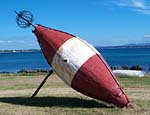Last of many nun & can Bouys used to mark the rocks and reefs of the Tamar River, evidence of building by convict coopers at Port Arthur.
Pilot Station & Maritime Museum

The Pilot Station was est. in 1805, the oldest building on site was convict built in 1835 of blue stone rubble walls and convict handmade brick interior, this accommodated 4 pilots and their families and now houses the Maritime Museum, research centre & archives and the Sir Raymond Ferrall Gallery. The other dwellings house visitor accommodation and the Pilot Station crew.
Subject:
- Maritime Museum
- Architecture
- Art
- Drawings and Prints
- Metalwork
- Archaeology or Antiquities
- Archives
- Numismatics, Coins and Currency
- Exploration
- Historic Buildings
- Historic People
- Maritime and Naval History
- Prisons or Convicts
- Social History
- Weapons Arms and Armor
- Building Technology
- Communications
- Marine Technology
- Ships and Shipping
- Telecommunications
- Models
Items
Wooden Nun Bouy
Hebe Reef Bouy
Steam Engine
Ponrabbel II, Port Engine
Port Engine from Ponrabbel II. Bucket dredge arrived from Scotland 1921 worked until 1972, Starboard engine on display at the Australian Maritime College, Launceston.
Diving Suit and Air Pump
The Port of Launceston employed their own salvage group for recovering lost cargos, wharf maintenance and the placing of explosives for harbour improvements.
Cat Boat
Trixie
One of 12 (maybe), built by Jack on order from Mr Perrin (Launceston businessman on return from WW1) all sailed at Lagoon Bay on the Tamar.
Log Books/Letter Book
A 17,000 card index and 12 filing cabinets of associated files currently being entered onto a computer.
